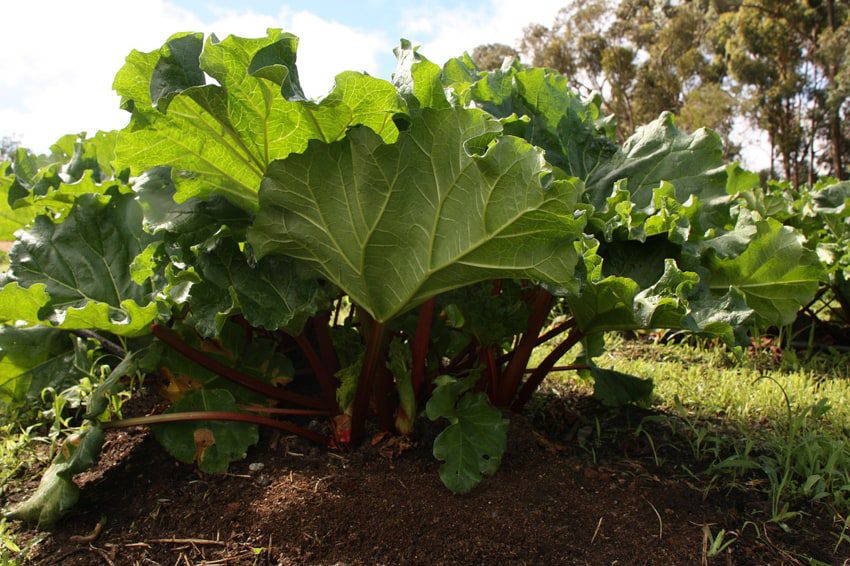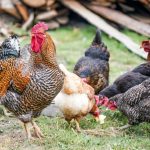Rhubarb is a very easy to grow perennial vegetable that produces large petioles (“stalks”) that are commonly used in pies, jams, and other desserts. The tart and tangy flavor pairs wonderfully with sugar. Rhubarb is actually a vegetable, though it is often prepared like a fruit.
When planting rhubarb, it’s important to choose the right companion plants to help maximize growth, improve flavor, and deter pests. Strategic companion planting takes advantage of how certain plants interact and support each other.
This article will cover the following topics regarding the best companion plants for rhubarb:
Why Companion Plant Rhubarb
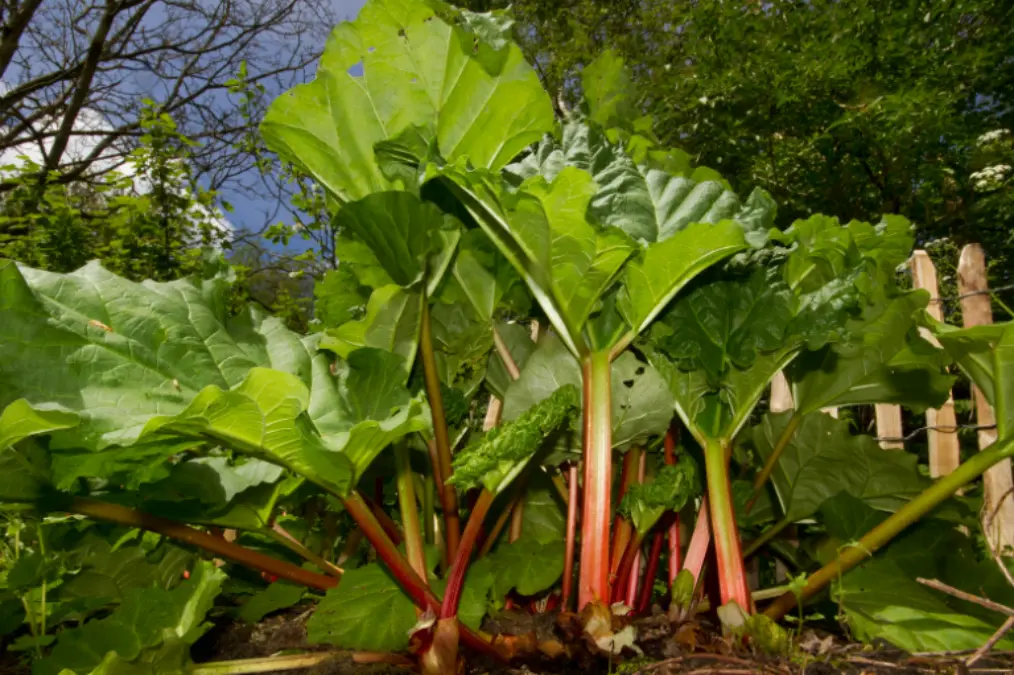
There are several key reasons why companion planting is beneficial when growing rhubarb:
Pest Control
Certain companion plants help repel common rhubarb pests like cabbage worms and aphids. This reduces the need for chemical pesticides.
Enhanced Flavor
Some plants improve soil nutrients which results in better tasting rhubarb stalks. Things like onions, garlic, and herbs make great flavor boosters.
Increased Yields
The right companion plants attract more pollinators which aids in rhubarb seed production and overall plant vigor. More bees means more rhubarb to harvest.
Efficient Use of Space
Companion planting allows multiple plants to grow in a small space. Less room is wasted and more crops can be grown.
Best Herb Companions for Rhubarb
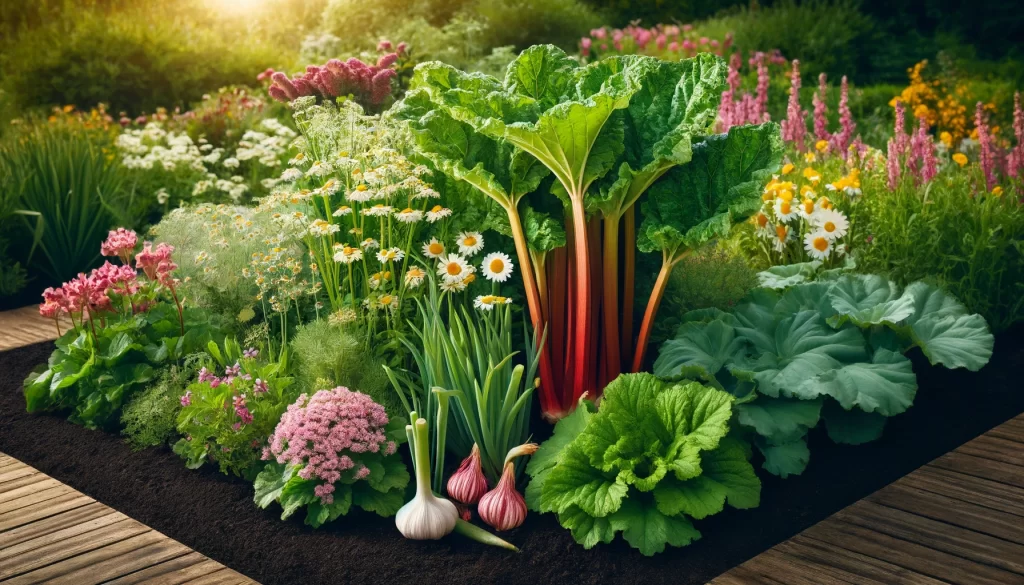
Herbs make excellent companion plants for rhubarb. Many common culinary herbs thwart pests, enhance flavor, and help rhubarb thrive:
Chives
Chives repel aphids, mites, and cabbage loopers. These small onion relatives also increase the potency of rhubarb’s tart flavor. Grow chives around the outer edges of rhubarb or interspersed throughout.
Coriander (Cilantro)
The flowers of the popular coriander plant attract beneficial insects that prey on rhubarb pests. Coriander also adds complementary flavor to rhubarb dishes. Sow cilantro seeds 1-2 weeks before transplanting rhubarb crowns.
Garlic
Garlic deters cabbage worms, Japanese beetles, and other insects that damage rhubarb. The pungent vegetable adds flavor depth as well. Plant garlic cloves around the rhubarb plants, about 6 inches away from the crowns.
Mint
Spearmint and peppermint varietals help mask rhubarb’s bold tartness, while attracting pollinators. Grow mint in pots near rhubarb plants to prevent mint from spreading aggressively. Do not plant directly in rhubarb beds.
Rosemary
Rosemary repels carrot flies which can also attack rhubarb. It also complements rhubarb’s tanginess. Grow rosemary from starts or cuttings around outer edges of rhubarb.
Best Vegetable Companions for Rhubarb
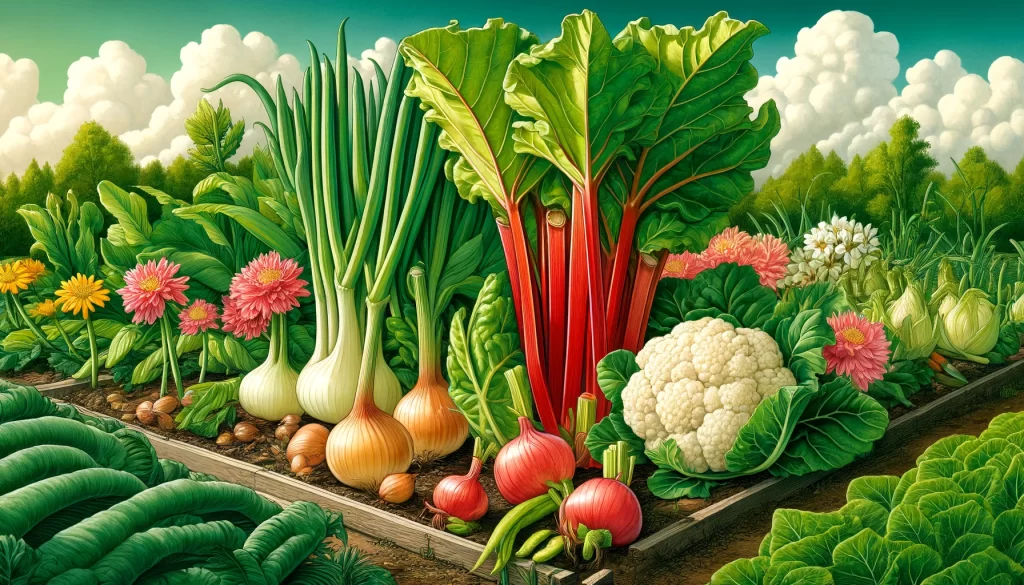
Many vegetable plants make smart rhubarb companion plants as well. Here are some of the best:
Beans
Pole bean plants provide a natural trellis for rhubarb leaves and stalks. Beans also enhance soil nitrogen which boosts rhubarb growth. Plant beans and rhubarb seedlings at the same time in spring.
Cabbage Family
Cabbage, broccoli, Brussels sprouts and other brassicas thrive alongside rhubarb. These large plants shade rhubarb roots while repelling borers. Allow at least 2 feet between brassica transplants and rhubarb divisions.
Lettuce & Spinach
Lettuce and spinach grow well in partial shade, making them ideal undersown companions. The shallow roots of leafy greens don’t compete with rhubarb. Direct sow lettuce and spinach seeds around established rhubarb crowns.
Onions & Leeks
Onions and leeks boost essential nutrients and sulfur in the soil. This adds pungency and tartness to rhubarb. Shallots, scallions, and other alliums work too. Plant onion sets 1-2 months before dividing mature rhubarb crowns.
Peas
Sweet peas supply the soil with nitrogen while using little space. Tall varieties can climb rhubarb stems. For best results, sow pea seeds 4-6 weeks prior to transplanting rhubarb divisions.
Radishes
Radishes have shallow roots so they won’t hamper rhubarb growth. They help break up and aerate soil too. Succession plant radishes every 2-3 weeks among young rhubarb crowns for continual harvest.
Other Helpful Rhubarb Companions

Beyond herbs and vegetables, a few other plants make good companions for rhubarb as well:
Borage
The bright blue borage blossoms attract loads of beneficial bees which pollinate rhubarb flowers. More pollination leads to higher seed production which boosts vigor. Borage thrives in shade so plant it around mature rhubarb leaves.
Marigolds
Pretty marigolds exude an aromatic chemical called thiophene that helps deter nematodes in soil. The small flowers also attract hoverflies that eat aphids. For best effect, transplant marigold seedlings around the outer edges of rhubarb crowns.
Nasturtium
Trailing nasturtium vines provide ground cover and mulch which helps retain soil moisture. Nasturtiums also repel aphids, whiteflies and other flying pests. The edible flowers add a nice peppery flavor when paired with tart rhubarb too.
Strawberries
Strawberry plants thrive alongside rhubarb plants. They utilize space efficiently while protecting roots. The sweet berries also balance out tart rhubarb wonderfully in recipes. Transplant young bare-root strawberry starts in early spring when dividing rhubarb.
Companion Planting Rhubarb Guide
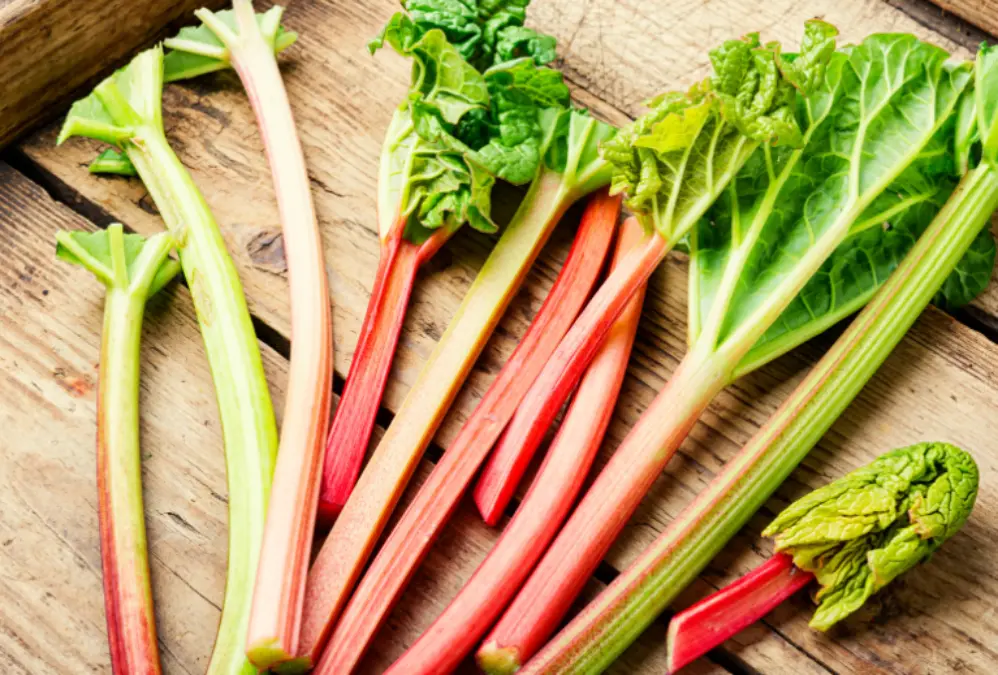
Follow this simple guide for pairing the right companion plants with rhubarb:
Location
- Plant rhubarb in a sunny well-drained area of the garden. Most companions appreciate sun as well.
Crop Rotation
- Move rhubarb (and companions) to a new area of the garden bed every 3-4 years to reduce disease and nutrient deficiencies.
Raised Beds
- Grow rhubarb in raised garden beds or rows at least 30-inches across to provide space for companion plants.
Transplanting
- Transplant young rhubarb crowns and companion seedlings early in cool spring weather for best establishment.
Division Spacing
- Space mature rhubarb crown divisions 2-3 feet apart. Allow a bit less space for dwarf and compact companion varieties.
Outer Plantings
- Surround rhubarb along the garden bed edges with beneficial herbs and flowers that attract pollinators.
Underplantings
- Fill in area around rhubarb with undersown lettuce, radishes, spinach and other fast growers.
Interplanting
- Intersperse taller companions like pole beans, brassicas and alliums between rhubarb crowns for balanced distribution.
Companion Planting for Optimal Rhubarb Growth
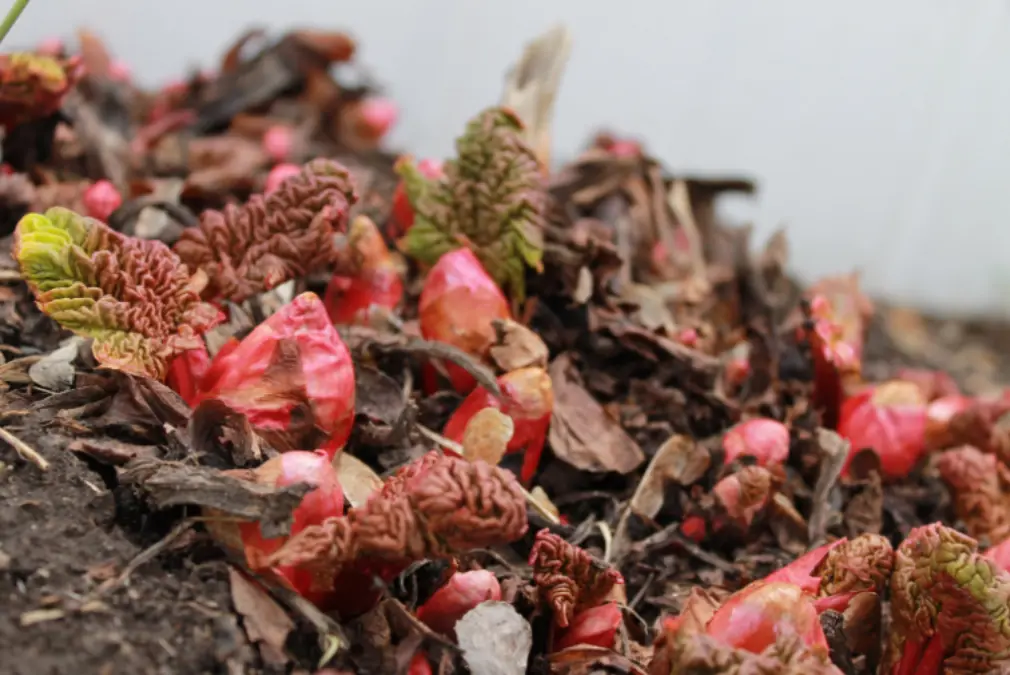
When laid out properly, the ideal rhubarb companion planting scheme might look something like this:
Imagine a sunny, fertile raised bed with established rhubarb crowns divided every 3 feet down the center row. Surround the outer edges with insect-repelling herbs like garlic, chives, peppermint and borage.
Underplant quick-growing lettuce, spinach and radish seeds around the young rhubarb leaves. Over time, the leafy greens will be shaded out as the rhubarb expands, creating a living mulch.
As bare spots emerge, transplant brassica seedlings, onion sets, strawberry plants and marigold starts in the gaps between. Finally, sow cilantro and install trellised pole beans to utilize vertical space.
This symbiotic scheme maximizes pest protection, soil nutrition and available space. The result is an attractive, productive garden bed with thriving rhubarb and delicious harvest for the whole season.
Troubleshooting Common Rhubarb Companion Planting Issues
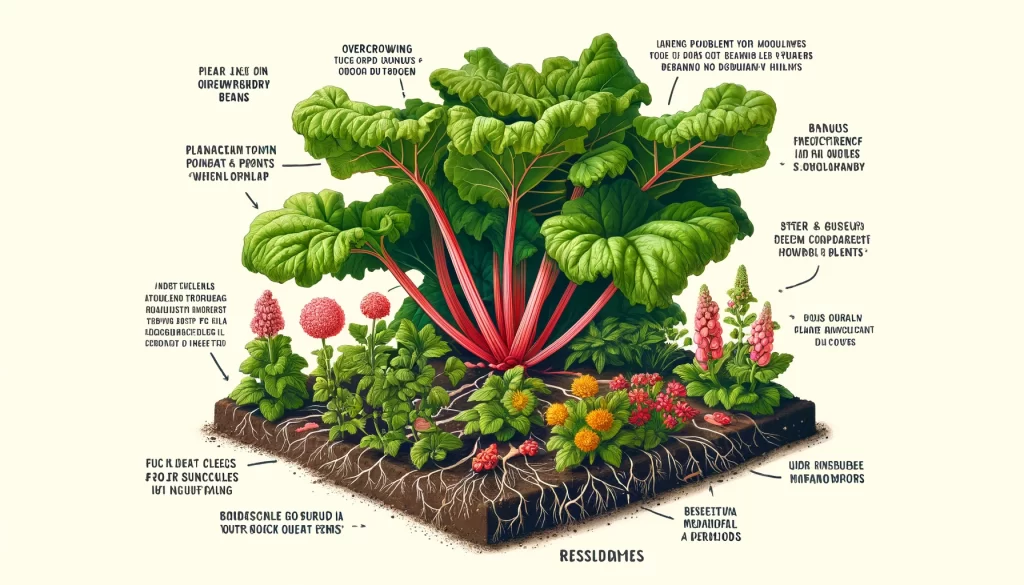
Even with the best laid plans, problems occasionally arise when companion planting:
Poor Growth
If rhubarb plants appear stunted with curled, wilted leaves, nutritional deficiencies may be the cause. Remedy by working aged manure, compost or other nitrogen-rich amendments into the surrounding soil.
Leggy Stems
Tall, thin rhubarb stalks often result from inadequate sunlight. This can happen when companion plants encroach too closely. Carefully trim back nearby plants to allow more light penetration.
Pest Infestations
A bad bug attack likely means repellent companion plants are absent or improperly positioned. Increase the amount of pest-fighting companions like garlic, onions and marigolds around affected rhubarb.
Small Harvest
Low rhubarb yields may be linked to pollinator scarcity. Try adding more bee-attracting blossoms like borage, nasturtiums, coriander and strawberries nearby to encourage pollination.
With attention to planting layout, maintenance and prompt issue resolution, a thoughtfully designed rhubarb companion garden will provide heavy harvests for many years to come.
Pros and Cons
Pros:
- Pest control: Many companion plants like chives, onions, and marigolds help repel common rhubarb pests naturally. This reduces the need for pesticides.
- Enhanced flavor: Onions, garlic, herbs and some flowers can improve rhubarb flavor when planted nearby.
- Increased pollination: Borage, coriander, strawberries and other flowering companions attract more bees to pollinate rhubarb.
- Efficient use of space: Companion planting allows multiple plants to grow in one plot, maximizing crop yields.
- Soil improvement: Some companions like peas and beans add nitrogen, while others aerate soil for better growth.
- Weed reduction: The dense foliage and living mulch from companion plantings helps suppress weeds.
Cons:
- Competition: Pairing plants with different growth times and water/nutrient needs minimizes competition, but it can still be an issue.
- Careful planning: Companion planting takes more thought and strategizing compared to solo crop planting.
- Possible overcrowding: Too many plants together may cause poor air circulation and reduced light for the rhubarb.
- Additional maintenance: More plants means more overall upkeep like watering, feeding, pruning and harvesting.
- Down time between rotations: Transitioning companions to a new plot every few years means reduced harvests short-term.
Frequently Asked Questions (FAQs)
Nasturtium, borage, marigolds and coriander flowers all complement rhubarb very well. They help deter pests, attract pollinators, and some are edible.
Beans, brassicas, onions/leeks, lettuce/spinach, radishes and peas all make great rhubarb vegetable companions. Plant a mix for balanced soil nutrition.
Yes, strawberries thrive next to rhubarb plants. They utilize space efficiently while protecting roots. The sweet berries also balance out tart rhubarb wonderfully in recipes.
Rotating rhubarb (and its companion plants) to a new garden location every 3 or 4 years helps prevent disease and nutrient deficiencies in the soil.
Yes, rhubarb is a cold-hardy perennial vegetable. Mature crowns can produce stalks every spring for 10-15 years or more when grown in ideal conditions.
Final Thoughts
Adding complementary companion plants around rhubarb helps create an attractive, productive garden plot. Thoughtful companion planting not only boosts yields, but deters pests, enhances flavor, and brings ecological diversity through increased pollination.
When pairing the right herb, vegetable and flower companions with rhubarb, even small garden spaces can yield plenty of delicious stalks for harvesting year after year.
So try companion planting proven pest-fighters like garlic and onions alongside heavy feeders like beans and brassicas. Undersow lettuce and herbs while trellising vines overhead. Scatter blossoms for bees amongst it all.
The result will be healthy, vigorous rhubarb primed for baking the best pies and crisps all season long!


